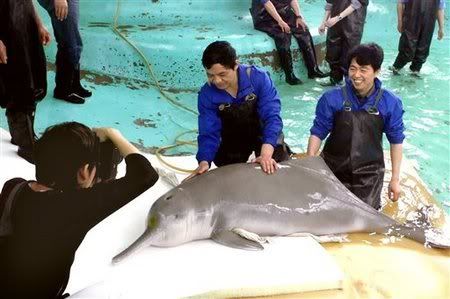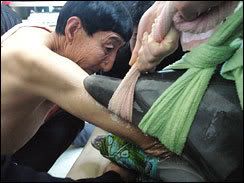"A rare, nearly blind white dolphin that survived for millions of years is effectively extinct, an international expedition declared Wednesday after ending a fruitless six-week search of its Yangtze River habitat.
 Specialists prepare to examine Qi Qi, a Yangtze River dolphin in captivity, in an aquarium in Wuhan, capital city of China's Hubei province, in this June 13, 2002 file photo. An international expedition to search for a rare Chinese river dolphin has ended without a single sighting, and researchers said Wednesday, Dec. 13, 2006 that the aquatic mammal is facing imminent extinction.
Specialists prepare to examine Qi Qi, a Yangtze River dolphin in captivity, in an aquarium in Wuhan, capital city of China's Hubei province, in this June 13, 2002 file photo. An international expedition to search for a rare Chinese river dolphin has ended without a single sighting, and researchers said Wednesday, Dec. 13, 2006 that the aquatic mammal is facing imminent extinction.The baiji would be the first large aquatic mammal driven to extinction since hunting and overfishing killed off the Caribbean monk seal in the 1950s.
For the baiji, the culprit was a degraded habitat - busy ship traffic, which confounds the sonar the dolphin uses to find food, and overfishing and pollution in the Yangtze waters of eastern China, the expedition said.
"The baiji is functionally extinct. We might have missed one or two animals but it won't survive in the wild," said August Pfluger, a Swiss economist turned naturalist who helped put together the expedition. "We are all incredibly sad.
The baiji dates back 20 million years. Chinese called it the "goddess of the Yangtze." For China, its disappearance symbolizes how unbridled economic growth is changing the country's environment irreparably, some environmentalists say.
"It's a tremendously sad day when any species goes extinct. It becomes more of a public tragedy to lose a large, charismatic species like the river dolphin," said Chris Williams, manager of river basin conservation for the World Wildlife Fund in Washington.
"The loss of a large animal like a river dolphin is often a harbinger for what's going on in the larger system as whole. It's not only the loss of a beautiful animal but an indication that the way its habitat is being managed, the way we're interacting with the natural environment of the river is deeply flawed ... if a species like this can't survive."
Randall Reeves, chairman of the Swiss-based World Conservation Union's Cetacean Specialist Group, who took part in the Yangtze mission, said expedition participants were surprised at how quickly the dolphins disappeared.
"Some of us didn't want to believe that this would really happen, especially so quickly," he said. "This particular species is the only living representative of a whole family of mammals. This is the end of a whole branch of evolution."
The damage to the baiji's habitat is also affecting the Yangtze finless porpoise, whose numbers have fallen to below 400, the expedition found.
"The situation of the finless porpoise is just like that of the baiji 20 years ago," the group said in a statement citing Wang Ding, a Chinese hydrobiologist and co-leader of the expedition. "Their numbers are declining at an alarming rate. If we do not act soon they will become a second baiji."
Pfluger said China's Agriculture Ministry, which approved the expedition, had hoped the baiji would be another panda, an animal brought back from the brink of extinction in a highly marketable effort that bolstered the country's image.
The expedition was the most professional and meticulous ever launched for the mammal, Pfluger said. The team of 30 scientists and crew from China, the United States and four other countries searched a 1,000-mile heavily trafficked stretch of the Yangtze, where the baiji once thrived.
The expedition's two boats, equipped with high-tech binoculars and underwater microphones, trailed each other an hour apart without radio contact so that a sighting by one vessel would not prejudice the other. When there was fog, he said, the boats waited for the mist to clear to make sure they took every opportunity to spot the mammal.
Around 400 baiji were believed to be living in the Yangtze in the early 1980s, when China was just launching the free-market reforms that have transformed its economy. The last full-fledged search, in 1997, yielded 13 confirmed sightings, and a fisherman claimed to have seen a baiji in 2004.
At least 20 to 25 baiji would now be needed to give the species a chance to survive, said Wang.
For Pfluger, the baiji's demise is a personal defeat. A member of the 1997 expedition, he recalls the excitement of seeing a baiji cavorting in the waters near Dongting Lake.
"It marked me," he said. He went on to set up the baiji.org Foundation to save the dolphin. In recent years, Pfluger said, scientists like the eminent zoologist George Schaller told him to stop his search, saying the baiji's "lost, forget it."
During the latest expedition, an online diary kept by team members traced a dispiriting situation, as day after day they failed to spot a single baiji.
Even in the expedition's final days, members believed they would find a specimen, trolling a "hotspot" below the industrial city of Wuhan where Baiji were previously sighted, Pfluger said.
"Hope dies last," he said."
On the web: http://www.baiji.org










